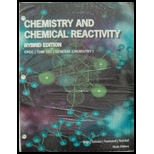
CHEMISTRY+CHEM...HYBRID ED.(LL)>CUSTOM<
9th Edition
ISBN: 9781305020788
Author: John C.Kotz, Paul M. Treichel, John Townsend, David Treichel
Publisher: CENGAGE C
expand_more
expand_more
format_list_bulleted
Concept explainers
Question
Chapter 22.3, Problem 4RC
Interpretation Introduction
Interpretation: The metal with coordination
Concept introduction:
Coordination compounds: The compounds having coordination covalent bonds which form when metal ions react with polar molecules or anions.
Monodentate ligand is ligands which donate only one pair of electrons to form bond with metal. It only makes one bond with metal. Polydentate ligand forms two or more coordination bond with metal ions to form a complex.
Coordination number: The total number of ligands that forms bond with the metal atom.
Expert Solution & Answer
Trending nowThis is a popular solution!

Students have asked these similar questions
A partir de Aluminio y Co(NO3)2ꞏ6H2O, indicar las reacciones a realizar para obtener Azul de Thenard (Al2CoO4).
To obtain Thenard Blue (Al2CoO4), the following reaction is correct (performed in an oven):Al(OH)3 + Co(OH)2 → Al2CoO4 + 4 H2O
Problem 38 can u explain and solve thanks april 24
Chapter 22 Solutions
CHEMISTRY+CHEM...HYBRID ED.(LL)>CUSTOM<
Ch. 22.1 - Prob. 1RCCh. 22.2 - Prob. 1QCh. 22.2 - 2. Describe the unit cell of austenite.
Ch. 22.2 - Prob. 3QCh. 22.2 - Prob. 1RCCh. 22.2 - Prob. 2RCCh. 22.3 - (a) What is the formula of a complex ion composed...Ch. 22.3 - (a) Determine the metals oxidation number and...Ch. 22.3 - Name the following coordination compounds. (a)...Ch. 22.3 - Prob. 1RC
Ch. 22.3 - 2. What is the oxidation number of the metal in...Ch. 22.3 - Prob. 3RCCh. 22.3 - Prob. 4RCCh. 22.4 - What types of isomers are possible for the...Ch. 22.4 - Prob. 1RCCh. 22.4 - Prob. 2RCCh. 22.4 - Prob. 3RCCh. 22.4 - Prob. 4RCCh. 22.4 - Prob. 1QCh. 22.5 - Prob. 1CYUCh. 22.5 - Prob. 1RCCh. 22.5 - Prob. 2RCCh. 22.6 - Prob. 1QCh. 22.6 - Prob. 2QCh. 22.6 - Prob. 3QCh. 22.6 - Prob. 4QCh. 22.6 - Prob. 1CYUCh. 22.6 - Prob. 1RCCh. 22.6 - How are the d electrons of Pt distributed in a...Ch. 22.6 - What are the electron configurations for Nd and...Ch. 22.6 - Prob. 3CSCh. 22.6 - Prob. 4CSCh. 22.6 - Prob. 5CSCh. 22 - Prob. 1PSCh. 22 - Prob. 2PSCh. 22 - Identify a cation of a first series transition...Ch. 22 - Match up the isoelectronic ions on the following...Ch. 22 - Prob. 5PSCh. 22 - Prob. 6PSCh. 22 - Which of the following ligands is expected to be...Ch. 22 - One of the following nitrogen compounds or ions is...Ch. 22 - Prob. 9PSCh. 22 - Prob. 10PSCh. 22 - Prob. 11PSCh. 22 - Prob. 12PSCh. 22 - Prob. 13PSCh. 22 - Prob. 14PSCh. 22 - Prob. 15PSCh. 22 - Prob. 16PSCh. 22 - Give the name or formula for each ion or compound,...Ch. 22 - Prob. 18PSCh. 22 - Prob. 19PSCh. 22 - Prob. 20PSCh. 22 - Prob. 21PSCh. 22 - Prob. 22PSCh. 22 - Prob. 23PSCh. 22 - Prob. 24PSCh. 22 - Prob. 25PSCh. 22 - Prob. 26PSCh. 22 - Prob. 27PSCh. 22 - Prob. 28PSCh. 22 - Prob. 29PSCh. 22 - Prob. 30PSCh. 22 - In water, the titanium(III) ion, [Ti(H2O)6]3+, has...Ch. 22 - Prob. 32PSCh. 22 - Prob. 33GQCh. 22 - Prob. 34GQCh. 22 - How many unpaired electrons are expected for...Ch. 22 - Prob. 36GQCh. 22 - Which of the following complex ions is (are)...Ch. 22 - Prob. 38GQCh. 22 - How many geometric isomers are possible for the...Ch. 22 - For a tetrahedral complex of a metal in the first...Ch. 22 - Prob. 41GQCh. 22 - Prob. 42GQCh. 22 - Prob. 43GQCh. 22 - A platinum-containing compound, known as Magnuss...Ch. 22 - Prob. 45GQCh. 22 - Prob. 46GQCh. 22 - Prob. 47GQCh. 22 - How many geometric isomers of the complex ion...Ch. 22 - Prob. 49GQCh. 22 - Prob. 50GQCh. 22 - Prob. 51GQCh. 22 - The square-planar complex Pt(en)Cl2 has chloride...Ch. 22 - The complex [Mn(H2O)6]2+ has five unpaired...Ch. 22 - Experiments show that K4[Cr(CN)6] is paramagnetic...Ch. 22 - Give a systematic name or the formula for the...Ch. 22 - When CrCI3 dissolves in water, three different...Ch. 22 - Prob. 57GQCh. 22 - The glycinate ion, H2NCH2CO2, formed by...Ch. 22 - Prob. 59GQCh. 22 - Nickel and palladium both form complexes of the...Ch. 22 - The transition metals form a class of compounds...Ch. 22 - Cerium, as noted in Applying Chemical Principles:...Ch. 22 - Prob. 64GQCh. 22 - Two different coordination compounds containing...Ch. 22 - Prob. 71SCQCh. 22 - Prob. 69SCQCh. 22 - Prob. 70SCQ
Knowledge Booster
Learn more about
Need a deep-dive on the concept behind this application? Look no further. Learn more about this topic, chemistry and related others by exploring similar questions and additional content below.Similar questions
arrow_back_ios
SEE MORE QUESTIONS
arrow_forward_ios
Recommended textbooks for you
 ChemistryChemistryISBN:9781305957404Author:Steven S. Zumdahl, Susan A. Zumdahl, Donald J. DeCostePublisher:Cengage Learning
ChemistryChemistryISBN:9781305957404Author:Steven S. Zumdahl, Susan A. Zumdahl, Donald J. DeCostePublisher:Cengage Learning Chemistry: An Atoms First ApproachChemistryISBN:9781305079243Author:Steven S. Zumdahl, Susan A. ZumdahlPublisher:Cengage Learning
Chemistry: An Atoms First ApproachChemistryISBN:9781305079243Author:Steven S. Zumdahl, Susan A. ZumdahlPublisher:Cengage Learning
 Principles of Modern ChemistryChemistryISBN:9781305079113Author:David W. Oxtoby, H. Pat Gillis, Laurie J. ButlerPublisher:Cengage Learning
Principles of Modern ChemistryChemistryISBN:9781305079113Author:David W. Oxtoby, H. Pat Gillis, Laurie J. ButlerPublisher:Cengage Learning Chemistry: Principles and ReactionsChemistryISBN:9781305079373Author:William L. Masterton, Cecile N. HurleyPublisher:Cengage Learning
Chemistry: Principles and ReactionsChemistryISBN:9781305079373Author:William L. Masterton, Cecile N. HurleyPublisher:Cengage Learning Chemistry: The Molecular ScienceChemistryISBN:9781285199047Author:John W. Moore, Conrad L. StanitskiPublisher:Cengage Learning
Chemistry: The Molecular ScienceChemistryISBN:9781285199047Author:John W. Moore, Conrad L. StanitskiPublisher:Cengage Learning

Chemistry
Chemistry
ISBN:9781305957404
Author:Steven S. Zumdahl, Susan A. Zumdahl, Donald J. DeCoste
Publisher:Cengage Learning

Chemistry: An Atoms First Approach
Chemistry
ISBN:9781305079243
Author:Steven S. Zumdahl, Susan A. Zumdahl
Publisher:Cengage Learning


Principles of Modern Chemistry
Chemistry
ISBN:9781305079113
Author:David W. Oxtoby, H. Pat Gillis, Laurie J. Butler
Publisher:Cengage Learning

Chemistry: Principles and Reactions
Chemistry
ISBN:9781305079373
Author:William L. Masterton, Cecile N. Hurley
Publisher:Cengage Learning

Chemistry: The Molecular Science
Chemistry
ISBN:9781285199047
Author:John W. Moore, Conrad L. Stanitski
Publisher:Cengage Learning